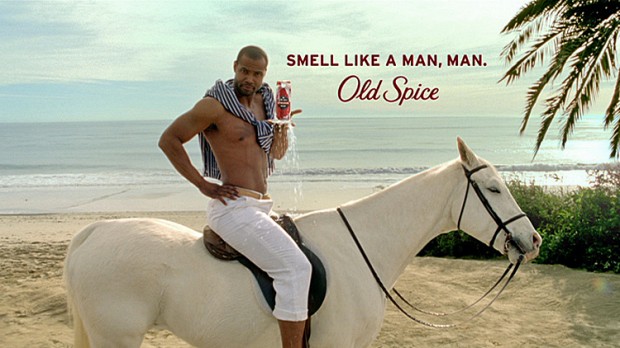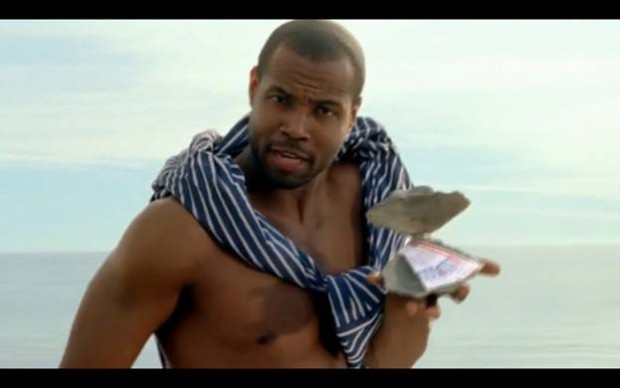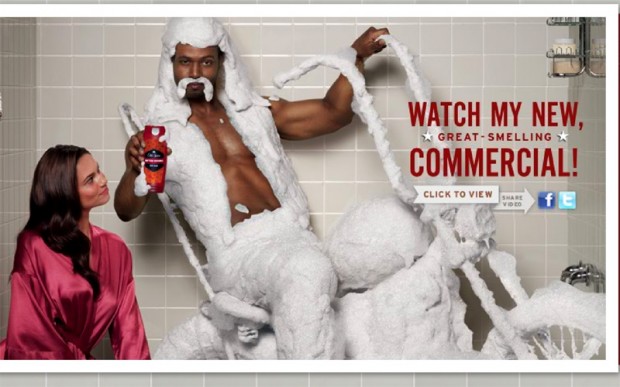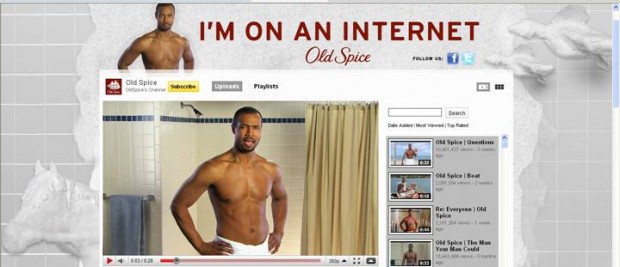Notes
Sell Like a Man, Man
Hello, readers. Look at the picture—now back to the words—now back to the picture—now back to the words . . . where are you? You’re on the Internet, with the social media campaign your next social media campaign could sell like.
By now you’ve probably seen several versions of the successful “Old Spice Guy” ad campaign—which originated with a pricey Superbowl debut. It is, of course, a huge commercial success– PC World touts it as perhaps “the most brilliant ad campaign ever,” Mashable calls it the “archetype of a successful social media campaign,” and even an old media stand-by like NPR reported that Old Spice Guy’s YouTube videos are “being hailed as the fastest-growing viral video campaign of any product in history.”
Perhaps more interesting than the ad campaign’s commercial success are the progressive political props the spots are getting. Writing for The Root (in an article titled “Why the Old Spice Guy is Good for Black America”), Cord Jefferson states that Old Spice Guy bucks the more familiar notions of black masculinity typically portrayed in advertising (you know, hypersexualized, animalistic, and brutish). Jefferson notes, “There was a time when a muscular black man addressing America’s ‘ladies’—not just black ladies but all ladies—in a sexualized tone could have gotten him killed.” Jefferson continues, saying that Old Spice Guy, by contrast, is presented as the “apex of manhood . . . here in 2010, far from being fearful, America is rushing wildly into his sturdy embrace.”
The visual architecture of the ad campaign suggests the ways in which the company is playing with form and expectations. As the towel-clad spokeshunk addresses his “lady” audience, he reminds them of the mediocrity of their own lives: “Look at your man, now back to me . . . sadly, he isn’t me, but if he stopped using lady-scented body wash and switched to Old Spice, he could smell like he’s me.” Instead of asking you to buy the fantasy, this ad campaign starts with more modest goals.
Mindful, however, of the genre’s expectations (personal product ads always sell the fantasy), the producers poke fun at that, as well, picturing Old Spice Guy as he log rolls in the mountains, waltzes through a gourmet kitchen he built for his lady (and in which he bakes cakes for her), and swan dives into a hot tub that also contains a motorcycle—presumably for him to ride into the next female fantasy. The humor comes not only from the obviously stereotypical nature of the “female fantasies,” but also from the artifice of the production—digital images split in two, staged backdrops topple as he strides confidently from one scene to the next—making the ads a pitch-perfect spoof of the personal product ad genre.
At this point I’m going to confess that I laugh at these commercials—their good-natured goofiness and male (as opposed to female) objectification seem almost as refreshing as body wash that’s not “lady-scented.” However, when I examine them a bit more closely, I see the contours of a more familiar ad narrative.
The ads rely on stereotypes about women for the humor to ring true. As he strolls across the deck of a boat, Old Spice Guy asks, “What’s in your hand? Back at me. I have it. It’s an oyster with two tickets to that thing you love. Look again. The tickets are now diamonds!” Everyone knows that even an ideal man wouldn’t know exactly what his women likes, much less like it himself (he’s probably much too manly). And, in a pinch, women just want diamonds—purchased for them by their man and his manly salary.
In another example, The Old Spice web site features this still:
You’ve got the typical sexy woman, placed in a submissive pose, looking adoringly at the man, who is poised to make all her dreams come true (because, of course, women dream primarily about sexual satisfaction—at least when they’re not busy fantasizing about diamonds or cake). That’s right, we ladies like our manly men any way we can get them—even covered head to toe with shaving cream (yum!) . . . while riding a motorcycle (exciting!) . . . in our bathtub (uh, okay, that’s a little weird).
The disappointment of the Old Spice Guy ad campaign is that the progressive image of black masculinity is only funny—and only makes sense—when it is wedged into another narrative (one as familiar as the racist story that Old Spice Guy tries to displace). Women desire (and are most desirable when conforming to) patriarchal male sexuality.
That narrative is carried through to the YouTube portion of the campaign, where Old Spice Guy (astride the Internet instead of a horse) answers questions tweeted to him: “WSpencer tweets: ‘Old Spice, am typing while running from a stampede of scantily clad female admirers who appeared after trying Old Spice. Is there an antidote?’ WSpencer: this is a common and life-threatening side effect of Old Spice Body Wash.” This ad seems to be an homage to the Axe Body Spray campaign, which is premised entirely on packs of wild young women who descend on unsuspecting, sexy men.
Even the aforementioned progressive African-American commentator was willing to metaphorically throw women under the bus as he promoted Old Spice Guy’s 21st-century appeal. Jefferson urged that even with “problems with heteronormativity and misogyny–all women love diamonds!—aside, the Old Spice Guy spots are funny in the offbeat and visually exciting manner Internet audiences demand. . . . That smells like progress, man.”
Ah, the smell of patriarchal masculinity in the morning . . . . (insert the Old Spice whistle here).
Streaming videos and stills available at www.oldspice.com
Shower/towel image obtained here.








Reactions
Comments Powered by Disqus